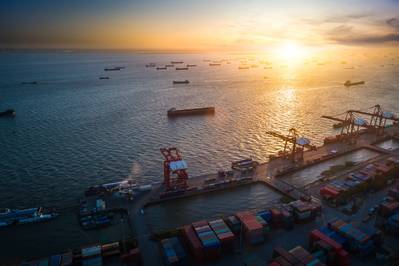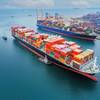Macroeconomic Trends Signal Good News for Shipping
The current global economic growth (GDP) looks like it may be as good as it gets, with indicators across the globe signaling healthy expansion, but at a slower pace compared to the levels seen in the last half of 2017.
Global economic growth seems on track to reach its highest level since 2011, as the International Monetary Fund (IMF) maintain its projection for the world GDP at 3.9 percent and expects the global economic growth to be supported by a strong momentum, favorable market sentiment and accommodative financial conditions in 2018 and 2019. This is good news for all shipping sectors.
Despite the status quo for the overall growth of the global economy, the IMF has lifted its projecting for the advanced economies’ output by 0.2 percentage points for 2018 to 2.5 percent, while maintaining its expectations for 2019 at 2.2 percent. The development is broad based and driven by the euro area, Japan and expected spillover effects from fiscal policies in the U.S. The continuous strengthening of the advanced economies is beneficial for the shipping industry, more notably the container shipping industry, as growth in advanced economies has the highest impact on trade (trade-to-GDP multiplier).
The Manufacturing Purchasing Managers Index (PMI) has been highly discussed in the recent months. The PMI development is not only an important indicator for the global economy, but also for the shipping industry. The global Manufacturing PMI signaled a peak in the global business cycle in 2017.
The recent PMI-decline in 2018 - across regions - has already caused anxiety about the recovery’s strength and thereby also introduced a question mark over the current strength of shipping demand. However, it must be emphasized that the current level of the PMI is still above the threshold level of 50, signaling an expansion in the underlying economics. It simply happens at a slightly slower rate compared to 2017.
Europe
Even though the EU Manufacturing PMI is not continuing at the same strong pace as in 2017, the IMF has increased its expectations for the euro area output by 0.2 percentage points for 2018, now amounting to a growth rate of 2.4 percent. This is primarily due to a stronger-than-expected domestic demand, supported by monetary policy and improved external demand. The expectations for 2019 remain unchanged at 2.0 percent for the euro area.
The Manufacturing PMI for Europe reached an eleven-year peak in December 2017 but has lost some tempo in 2018. The current level is however still robust by historic standards and is seen as a moderation of the growth pace, not a setback. The strong growth in 2017 has created short-term capacity constraint’s limiting the economy’s ability to grow at the same expansive rate for a long period and the slower 2018 growth speed can be considered ordinary.
Usually, when manufacturing speeds up, the imports of raw materials increase. However, over the last decade Europe’s manufacturing industry has transformed towards higher value-added activities done through higher-skilled activities. The consequence is that more activity comes from the production of consumer goods and capital goods (goods used in the production of goods or services) and less activity comes from the production of intermediate goods (the production of semi-finished goods used in the production process of other goods). The capital goods and consumer goods are primarily transported via containers and the intermediate goods as bulk or general cargo are impacted accordingly by this development.
U.S.
BIMCO’s Market Analysis Team has in recent months focused on how shipping will be affected from a full blown trade war between U.S. and China. With shipping being a demand derived activity, an escalating trade war with many more commodities involved, could trigger something bigger that would negatively impact global shipping in a much wider way including the transpacific container trade.
The impact of the trade-restrictive measures enacted to ‘safeguard’ the U.S. steel and aluminum production is still unknown. The U.S. imported 32 million metric tons of the specific tariffed aluminum and steel commodities via the sea in 2017 (Source: U.S. Census Bureau).
For the shipping industry, shipments from Asia are more influential in terms of sailing distance and ton miles than volumes alone, with 83 percent of all the tariffed aluminum and steel commodities being imported via the U.S. East – and Gulf Coast.
The EU, Argentina, Australia, Brazil, Canada, Mexico and South Korea have been exempted from the tariffs imposed, and thereby half of U.S. imports of steel and aluminum are exempted. The seven trading partners exported 16 million metric tons of the tariffed steel and aluminum by sea to the U.S. in 2017.
From a wider perspective, and if Chinese retaliations are imposed in response to the first U.S. shot, they may weaken the current global upswing, with U.S. soya bean exports as the other main dry bulk trade that could be affected - for better, if longer sailing distances comes around, or for worse, if cargoes are simply lost.
The IMF published their most recent projections after the Chinese retaliations were introduced. However, they have still increased their expectations for the U.S. output by 0.2 percentage points for 2018 and 2019, amounting to a growth rate of 2.9 percent in 2018 and 2.7 percent in 2018.
Asia
The IMF has maintained its expectation for the Chinese GDP for both 2018 and 2019. The expected growth is 6.6 percent in 2018 and 6.4 percent in 2019. The same picture is seen for Japan where projections for 2018 and 2019 are unchanged at 1.2 percent in 2018 and 0.9 percent in 2019.
The Chinese focus on credit tightening and a stronger push for limiting debt burdens is likely to reduce coming infrastructure investments in China (Source: 19th national congress, Reuters, Bloomberg, etc.). This will weigh on imports of iron ore and coal, as Chinese infrastructural investments are one of the main global dry bulk demand drivers.
After an unstable period in 2016, Japanese PM Shinzo Abe launched an economic stimulus package in August 2016, which stabilized the Japanese economy according to the economic indicators.
The Japanese Manufacturing PMI reached its highest level in 26 years in January 2018 and the industrial production growth has stayed in positive territory. The inflation rate seems finally to have released itself from its usual very marginal increase. Despite the increased inflation, The Bank of Japan has removed the timeframe for achieving its 2 percent inflation goal mainly due to headwinds from companies resisting raising prices and wages, due to uncertainty over the economic outlook. Higher inflation will spur higher consumer spending and benefit container shipping demand.
Outlook
Where to go next? With the IMF’s medium-term growth outlook dropping gradually from 3.9 percent in 2019 to 3.7 percent in 2023, policymakers need to enact reforms and build fiscal buffers, which will generate robust and inclusive growth and build resilience to the hazards ahead.
The trade multiplier for advanced economies has again returned to a level above 2 and the world trade multiplier has increased to 1.4, indicating that global trade increases by 1.4, when the global economy grows by 1 percent. However, this is as good as it gets, as the IMF expect advanced economies’ share of global GDP to continue its current decline and the world trade multiplier tracking back to 1.
In 2017 the trade multipliers reached their highest level since 2012 and combined with stronger GDP growth for both advanced economies and the world economy, higher volumes of trade benefitted the shipping industry. The trade multiplier for advanced economies is expected to continue to surge towards 2.3 before dropping below 2 in 2021 and going forward.
However, going forward as advanced economies are expected to account for a smaller share of global GDP, the world multiplier will start to be more and more influenced by emerging markets and developing economies, which will pull the multiplier towards 1.
If this development materializes the container shipping industry will see slower growth going forward, with demand growing only at the same pace as global GDP, which is a reversal for the industry.













